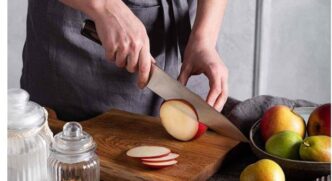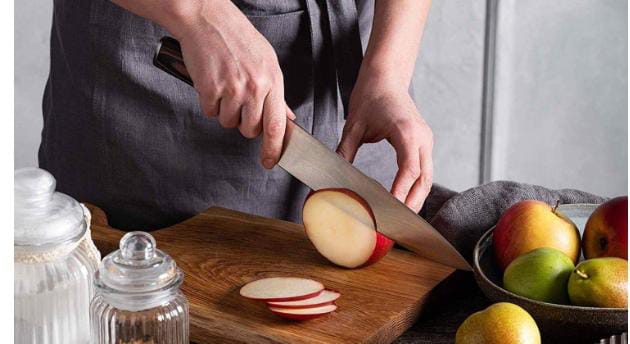Pick the right knife set and everything changes in the kitchen. Chopping stops feeling like a chore and starts moving quickly and smoothly. But with prices starting at 25andgoingpast25andgoingpast1,000, knowing what to buy can be tough. You have to figure out what makes a good knife, what features really matter, and why some sets cost so much more than others.
In this guide, we’ll walk you through everything you need to pick out the best knife set for your home kitchen. You’ll learn which knives you actually use every day, what pushes prices up or down, and see choices for every budget and cooking style.
Essential Knives Every Home Cook Needs
Chef Knife: Your Kitchen Workhorse
Ask any cook which knife they grab the most, and they’ll point to the chef’s knife. Ointing around 8 to 10 inches long, this one blade does about 80 percent of the jobs on your cutting board. It chops veggies, slices meat, and minces herbs as if the work never slows down.
A good chef’s knife starts with a sharp, lasting edge that stays ready even after plenty of use. Pick it up and the balance should feel just right, weight evenly split between the blade and handle so you stay comfy during long prep sessions.
Look for full tang construction, where the blade steel runs right through the handle from tip to end. This setup offers better balance, strength, and control than partial tang versions, which can crack apart when pushed hard.
Paring Knife: Precision for Detailed Work
The 3- to 4-inch paring knife shines on small jobs that feel clumsy with a bigger blade. Whether you are peeling apples or deveining shrimp, this little heavy-lifter gives you the fine touch needed for fancy food prep.
Good paring knives feel stiff and sport sharp tips that matter to precision tasks. Because the blade is short, the handle shape becomes critical—an awkward grip can tire your hand after peeling a pile of potatoes or making delicate garnishes.
Many budget paring knives use thin, bendy blades that wander and ruin clean cuts. Spending a little more on a quality knife pays you back in better performance and far less strain during long, detailed jobs.
Serrated Knife: Tackling Tough Textures
An 8- to 10-inch serrated knife is the star when dealing with foods that have tough skins and soft insides. Crusty bread, ripe tomatoes, and citrus fruits all slice cleanly thanks to the saw-like action of well-made serrated teeth.
The way a serrated knife cuts depends mostly on how well its teeth are made and how far apart they sit. Cheaper models usually have shallow, badly shaped teeth that rip instead of slicing neatly. A good serrated knife keeps working for years because its teeth guard the main edge from damage.
Because the serrations do most of the work, these blades hardly ever need to be sharpened during their entire life. That is why they are a smart buy for home cooks who want a steady performer with almost no upkeep.
Utility Knife: The Versatile Addition
Most knife blocks include a utility knife, a 4- to 6-inch blade that slips neatly between a chef knife and a paring knife. It is not absolutely required, yet it cuts sandwiches, small fruit, and mid-size veggies with ease.
Whether you really need a utility knife depends on how you cook. Some people use it for almost every meal, while others feel satisfied swapping in a chef or paring knife whenever the job comes up.
What Determines Knife Set Quality and Price
Blade Material: The Foundation of Performance
The steel in a kitchen knife does more than anything else to shape its quality and price. Plain stainless steel keeps the sticker price down, but it dulls faster and never gets as sharp as better options.
High-carbon stainless steel adds a little to the manufacturing price, yet cooks prize it for keeping its edge longer and taking on a hair-splitting sharpness. These alloys shrug off stains and still slice, chop, and dice with the ease that makes time in the kitchen a pleasure.
German steels forged by houses like Krupp carry a premium because their quality has been hammered out over centuries of blade-making know-how. On the other side of the world, Japanese grades such as VG-10 shine for razor edge, breathtaking sharpness, and long wear, though they usually land a bit higher than their German cousins.
Construction Methods: Full Tang vs. Partial Tang
In a full tang knife, the blade’s steel stretches the whole length of the handle, and that setup boosts performance and lifespan. The even weight makes the tool sit lightly in your hand during marathon chopping, and it guarantees the handle wont slip free over years of work.
Partial tang knives cost less to make because they use less metal, but that cut in steel hurts long-term trustworthiness. Theyll handle light weekend prep, sure, but ask them to service a daily cook and they can give up, so spending extra on full tang pays off down the road.
Another sign of solid build are the rivets pinning a full tang handle in place. Three rivets offer plenty of hold, though more fasteners show up in higher-end models for added strength and a bit of show on the countertop.
Handle Design and Materials
The material used for a knife handle can change how the tool feels in hand and how much you pay for it. Injection-molded plastic keeps prices down, but the surface often feels flimsy and can turn slippery when wet from washing or chopping.
Wood types like rosewood or olive wood look nice and, thanks to their natural texture, grip the hand very well. They do need a little care-sanding and oil now and then-to stop cracking or splitting. Because of that extra work, the price is higher, but many cooks find the comfort worth it.
Engineered materials such as G10 or Micarta hit a sweet spot in cost and performance. Both materials refuse to swell or stain, stay grippy even when soaked, and ask for no special upkeep. With regular use, they can last for years and still look and feel good.
Cooking Knife Price Ranges and What to Expect
Budget-Friendly Options ($25-75)
For cooks who only slice a few veggies now and then, a starter knife set in the 25−to−25−to−75 range is hard to beat. These packs usually bundle three to five pieces made of basic stainless steel and simple plastic or metal handles.
You should not expect professional-grade performance, yet they get the job done for simple weeknight meals. Just keep a honing rod nearby because the edge dulls faster than on pricier blades and, yes, they will start to show wear sooner, too.
Budget Options Under $75
Entry-level knife blocks work for people who cook at home a few times a week and dont want to break the bank. While many models look nice in the store, quality can still vary. Before buying, check for poor reviews about bent blades, chipping edges, or loose handles. Watch out for sets made mostly from cheap stamped stainless steel; they dull quickly and are hard to sharpen.
Mid-Range Excellence ($75-250)
The sweet spot for most home cooks sits between 75and75and250. Here, you get high-carbon stainless steel, comfy riveted handles, and blades that hold an edge through everyday chopping, slicing, and dicing. Typical sets include four to six knives and a wood block or magnetic strip for tidy storage. With regular wiping and light honing, mid-range knives can last years without major repair.
Pros in teaching kitchens often recommend these sets because the performance jump over budget lines is worth the modest price increase. Unless a home cook plans to slice bones or frost dozens of cakes every week, spending more on premium lines rarely pays off on the counter.
Premium Collections ($250-600)
At this range youll find hand-forged blades, rare woods or resins for the handles, and finishes so smooth they look like art. Each knife shows the brands heritage, minutes spent on sharpening stones, and complete control from tip to heel.
Serious home chefs who love technique and want tools that feel alive in the hand often invest here. With careful care the edge lasts longer, chips are rare, and the set may outlive its owner, becoming an heirloom.
Premium knife sets usually have fewer pieces than their budget cousins, putting quality ahead of sheer numbers. Because each knife is well made, one premium blade can do the work of several cheaper ones day in and day out.
Best Knife Set Recommendations by Category
Best Budget Choice: Mercer Culinary Genesis 6-Piece Set
At about $60, the Mercer Genesis set packs a lot of bang for the buck. Its high-carbon German steel blades stay sharp, and the comfy, ergonomic handles make chopping feel easy. The six pieces cover every basic task without adding random tools that bump up the price.
Culinary schools swear by Mercer, handing these knives to rookie chefs because they work hard and dont break the bank. The edges hold longer than you’d expect at this price, and the knives stay comfy even during marathon prep sessions.
You get a sturdy hardwood block that guards each edge while keeping everything neat and within reach. Put it all together, and you have a ready-to-roll kit that upgrades any home kitchen with dependable cutting gear.














